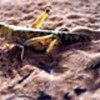UN says locusts threaten new invasions in northwest Africa, endangering food

In its latest update on the potential plague, the Rome-based agency reports that widespread breeding continued in the first half of this month throughout the Sahelian (sub-Saharan) Zone in Mauritania, Senegal, Mali, Niger and, to a lesser extent, Burkina Faso, with hopper bands rapidly developing in all countries.
Summer generation swarms continue to form in southeastern Mauritania with smaller-scale breeding in Cape Verde and Chad. Some 3 million to 4 million hectares may be infested in the Sahel, it adds.
Earlier this month FAO called the next two months “extremely crucial” and urged the world community to come up with the funding and equipment needed to prevent the crop-devouring insects from developing into a full-scale plague.
The update warns that a substantial number of swarms will form in the coming days and during October, with the majority moving to west and northwest Mauritania and breeding there, or reinvading Senegal and moving south towards Guinea. Significant damage to crops and pasture has already been reported and is expected to affect food security in Mauritania, Mali, Senegal and Niger.
With the expansion of aerial spraying capacity currently under way, the rate of control is likely to increase considerably but the medium-term forecast suggests that a large number of hopper bands could form in the spring breeding areas in northwest Africa next year.
In August FAO warned that the current infestation is potentially worse than the last plague of 1987-89, which cost the international community $300 million, and last month it stressed the urgent need to get large quantities of pesticides, spraying equipment and other means to the scene. Only $37 million of the requested $100 million had been pledged while the situation continued to deteriorate, it added.
